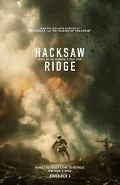
Directed by
Mel Gibson
138 minutes
Rated MA
Reviewed by
Bernard Hemingway

Hacksaw Ridge
Synopsis: Desmond Doss (Andrew Garfield) has grown up in a Virginian Seventh Day Adventist family. Determined to help out in the war effort, Desmond enlists under the misapprehension that he can fulfil the role of a medic without carrying a gun. Whilst his commanding officers,Sergeant Howell (Vince Vaughn) and Captain Glover (Sam Worthington) are determined to set him straight, Doss prevails and, during the bloody Battle of Okinawa, miraculously saves the lives of 75 soldiers without firing a single shot.
Much like Stanley Kubrick’s Full Metal Jacket (1987), Hacksaw Ridge is divided into two parts, the first dealing with events Stateside during initial training, the second with action overseas in the field of battle. If Kubrick’s film is more memorable with respect to the former aspect, Gibson wins hand down when it comes to depicting the intensity of battle in a film that is at once awesomely well-made and disappointingly conventional.
This contradiction works against the film particularly as its central theme, the story of a pacifist who joins the army to save lives, is a novel one in the annals of war movies but Gibson manages to make its real life story seem as improbable as any Hollywood big budget actioner. This is even more disappointing because the real Doss, who died in 2006, apparently would not allow his story to be told while he was still alive, his resistance to the idea going back more than forty years when producer Hal B. Wallis and actor/war-hero Audie Murphy approached him with the idea of turning into a film. It is no small irony that Gibson has, technical advances aside, turned in pretty much the film they would have made. The Duke, who no doubt would have played Drill Sergeant Howell (here surprisngly well played by Vince Vaughn), would have approved,
The first half of he film focuses on Desmond’s childhood and early manhood in 1930s rural Virginia, as a gee-shucks kind of kid growing up with a violent father (Hugo Weaving) with a drinking problem and a deeply religious mother (Rachel Griffiths). Although Desmond is a firm believer in the 6th Commandment - Thou Shalt Not Kill - in the wake of Pearl Harbour he enlists as a conscientious objector leaving behind the love of his life (Teresa Palmer). This introduction is a valuable foundation that allows us to believe in Doss’s bravely determined response to the brutal hazing he receives as a raw recruit and later as an unarmed medic in the heat of battle, which the second half of the film depicts in two extended sequences.
On the surface of it this sounds like material with potential and it is but Gibson and his screenwriters Andrew Knight (writer of ABC TV's Seachange) and American playwright Robert Schenkkan only touch on the vexing moral issues and devote most of their energy to packaging the story with just the kind of Hollywood screen heroics that Doss himself wished to avoid. The characters whether in Virginia or the army base are familiar types and whilst Garfield is convincing as the religiously dedicated young man, the narrative arc of his story has been seen innumerable times before, not least in the films of John Ford .
Most audiences will, however, immediately address themselves to Gibson’s relentless, graphically violent battle scenes which are big on soldiers with their legs blown off, viscera flowing into the dirt, heads bursting open under the impact of bullets, burning bodies flying through the air and so on in the kind of put-you-in-the-scene immediacy that Spielberg did in the opening scenes of Saving Private Ryan (1998). Gibson. perhaps trying to up the ante, gives us a double helping as Doss’s battalion undertakes a second assault (allegedly inspired by the medic's selfless bravery in the first unsuccessful attempt).
Whilst not only can one almost feel Gibson’s blood-lust in this it is even more questionable because the foe are a faceless horde of “Japs” (there are a couple of references to Doss helping Japanese soldiers). It’s not quite Sands Of Iwo Jima (1949) but it’s close. Indeed one feels that Gibson’s own well-attested Christologically infused personal demons are never far from the surface in his treatment of Doss’s story. Indeed it is not unfair to say that they co-opt it, for the story is very much one of quiet, steadfast humility and Gibson’s film is anything but.
Now this may make for interesting meta-level discussion, particularly in relation to the director’s The Passion of The Christ (2004), the result is that Doss’s amazing feat never seems plausible. We see Doss save maybe a half-dozen fellow soldiers, carrying them on his back, lowering them to safety with a conveniently-placed large rope while dodging bullets or in one instance dragging his drill sergeant along the ground on a blanket while the latter mows down Japs with a machine gun. The real Doss did this 75 times? Surely not or certainly not like this.
That this is a partly Australian funded film shot in New South Wales with a cast including many well-known Australian actors who all acquit themselves well (although Sam Worthington seems a little young to be a C.O.) is an encouraging fact. That it cleaned up every major AACTA awards in the year of its release, less so. Hacksaw Ridge is artistic license gone balmy, at once skillfully made and a missed opportunity.

Want more about this film?


Want something different?




